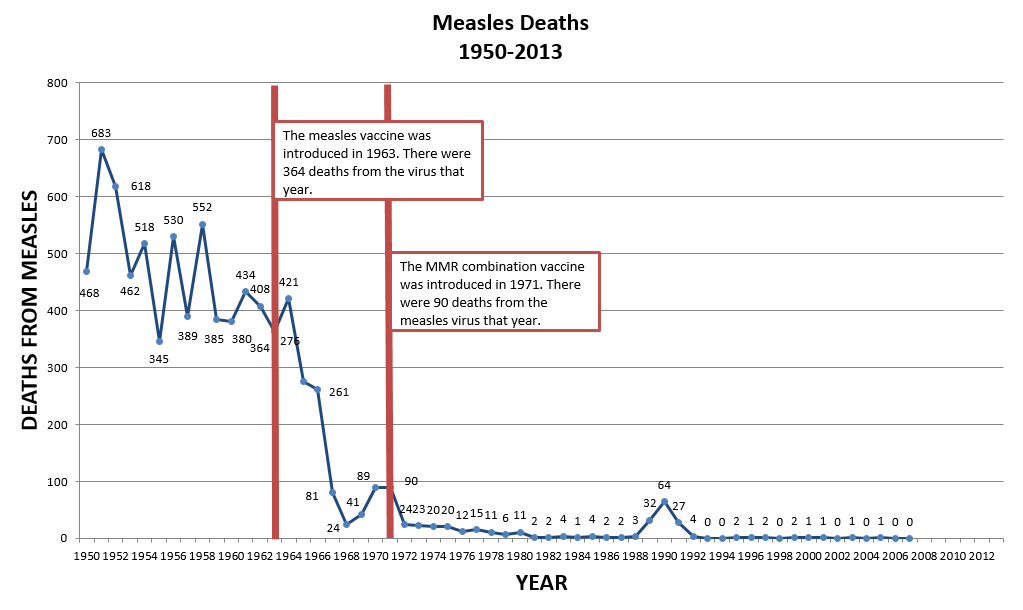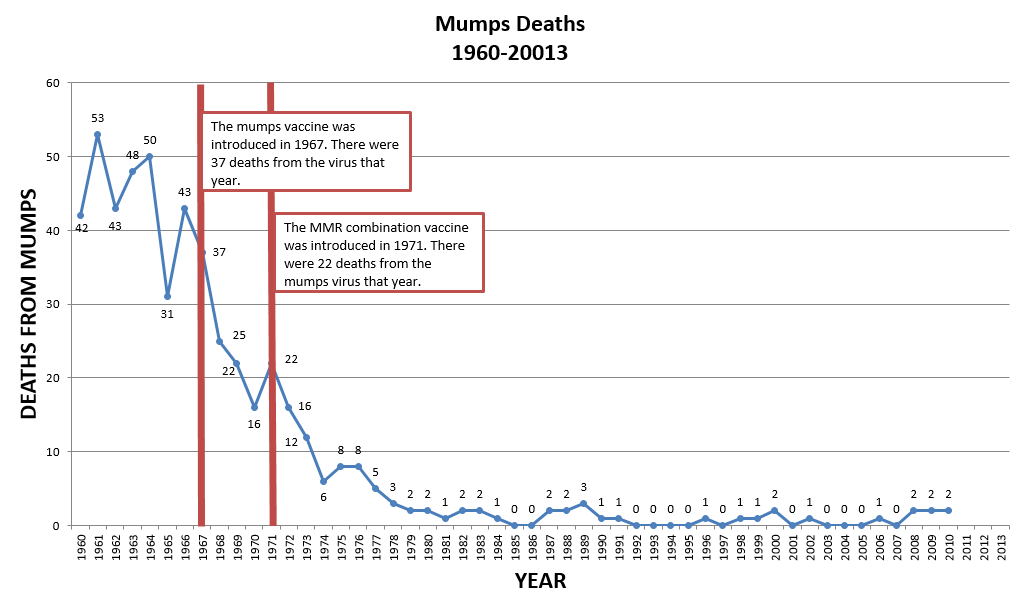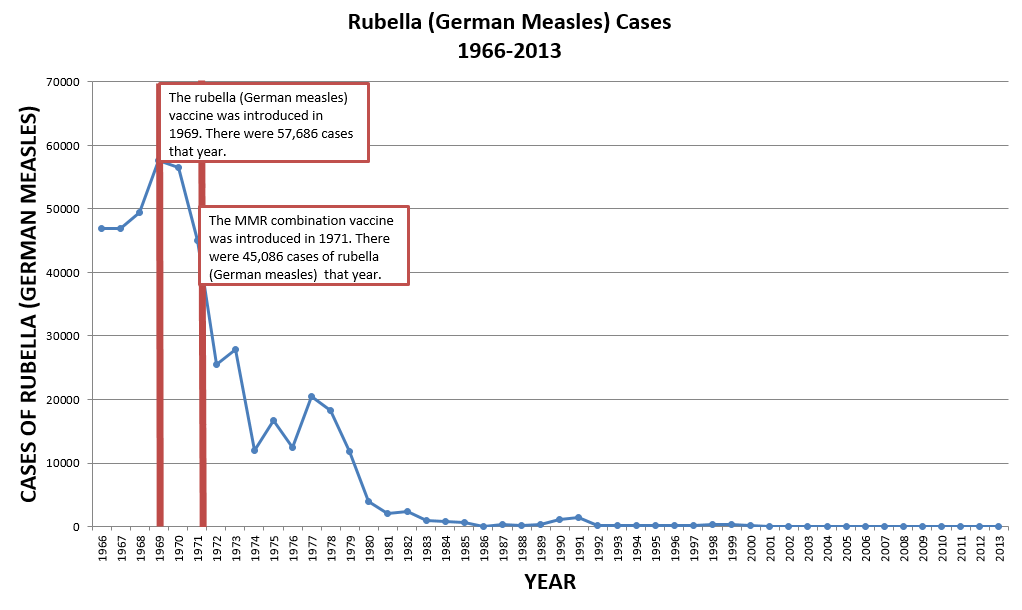Cases and Deaths, and MMR Vaccination Rates
MEASLES
The measles, according to the CDC, is “a highly contagious respiratory disease caused by the measles virus… Measles causes fever, runny nose, cough, and a rash all over the body. About one out of 10 children with measles also gets an ear infection, and up to one out of 20 gets pneumonia.”

Source: Sanofi Pasteur, “Measles Virus (Paramyxoviridae),” flickr.com, Aug. 7, 2013
In 900 AD, Rhazes, a Persian physician, distinguished measles from smallpox. In 1676, Thomas Sydenham, an English physician, added more detail in the distinction between the viruses and also distinguished measles from scarlet fever. Francis Home, a Scottish physician, successfully infected healthy patients with blood from patients with measles in 1757. In 1916, Charles Nicolle and Ernest Conseil, French researchers, discovered that people with measles developed protective antibodies in their blood, making them immune to the disease; the researchers used a serum made of the antibodies to show that the antibodies could protect healthy people from the virus.
On Feb. 8, 1954, Thomas Peebles isolated the measles virus from a blood sample of 13-year-old David Edmonston. On Oct. 15, 1958, Sam Katz, an infectious disease specialist who worked with Thomas Peebles, tested the first measles vaccine, which worked but caused measles symptoms. On Feb. 8, 1960, researchers in Boston tested a measles vaccine on children with intellectual disabilities in New York; the vaccine was effective at preventing illness but caused many side effects. In 1961, Henry Rubin, a virologist, developed a method of growing vaccines in chicken eggs to prevent leukemia that proved useful for developing the measles vaccine. In 1962 a killed-virus measles vaccines failed. In 1963, John Enders, a biomedical scientist and the “Father of Modern Vaccines,” and his team proved their measles vaccine was safe and effective to the FDA; the vaccine was licensed the same year. In 1968, Maurice Hilleman, debuted an improved version of the vaccine created that eliminated the use of human blood proteins and is still used as of July 22, 2014.
MUMPS
Mumps, according to the CDC, is “a contagious disease that is caused by the mumps virus. Mumps typically starts with a few days of fever, headache, muscle aches, tiredness, and loss of appetite, and is followed by swelling of salivary glands.”

Source: Sanofi Pasteur, “Mumps Virus (Paramyxovirus),” flickr.com, Aug. 7, 2013
In 1945 the mumps virus was isolated. In 1948 an inactivated vaccine was developed but it provided only short-term immunity and its use was discontinued in the 1970s. On Mar. 30, 1967 the FDA licensed Mumpsvax, a mumps vaccine developed by Maurice Hilleman that was created from the mumps virus that infected his five-year-old daughter, Jeryl Lynn. This Jeryl Lynn strain of live attenuated mumps virus vaccine is still used as of July 22, 2014.
RUBELLA (GERMAN MEASLES)
Rubella, according to the CDC, is “a disease caused by a virus. The infection is usually mild with fever and rash. But, if a pregnant woman gets infected, the virus can cause serious birth defects.”

Source: Sanofi Pasteur, “Rubella Virus (Togavirus),” flickr.com, Aug. 7, 2013
In 1740, Friedrich Hoffmann, German physician, gave the first clinical description of “German measles” (“Rötheln” in German) In 1841 the virus was referred to as “rubella” (meaning “little red”) in connection with an outbreak at a school in India. In 1866, Henry Veale, English surgeon, suggested renaming the virus “Rubella” to replace “Rötheln.”
In 1938, S. Tasaka and Y. Hiro, Japanese scientists, successfully transmitted rubella from sick children to healthy children but did not find the causative agent of the disease. In 1960 the rubella virus was isolated by Thomas Weller, a Harvard School of Public Health researcher, from his 10-year-old son who was infected with the virus. The first mumps vaccine was created by Maurice Hilleman, was first used in 1969.
In 1971, the combination MMR (measles, mumps, rubella) vaccine was licensed for use.
In 2005, a combination MMRV (measles, mumps, rubella, varicella) vaccine was licensed for use.
The CDC recommends that children receive the first dose of the MMR vaccination between 12 and 15 months of age.
Sources
CDC, “Measles (Rubeola),” cdc.gov, Aug. 1, 2014
CDC, “Mumps: Epidemiology and Prevention of Vaccine-Preventable Diseases, The Pink Book: Course Textbook – 12th Edition Second Printing (May 2012),” cdc.gov, July 7, 2014
CDC, “Overview of Mumps,” cdc.gov, Mar. 14, 2010
CDC, “Reported Cases and Deaths from Vaccine Preventable Diseases, United States, 1950-2013,” cdc.gov, Sep. 2014
CDC, “Rubella – Fact Sheet for Parents,” cdc.gov, July 8, 2013
CDC, “U.S. Vaccination Coverage Reported via NIS,” cdc.gov, Mar. 11, 2014
College of Physicians of Philadelphia, “The History of Vaccines: Timelines, Diseases and Vaccines,” historyofvaccines.org (accessed June 25, 2014)
National Network for Immunization Information, “Measles, Mumps, Rubella (MMR),” immunizationinfo.org, Apr. 22, 2010
| Measles Outbreak |
|---|
| Fighting Measles amid the COVID-19 Pandemic |
| US May Lose Measles Elimination Status Due to Ongoing Outbreaks |
| States Rethinking Childhood Vaccine Mandates during Measles Outbreak |









